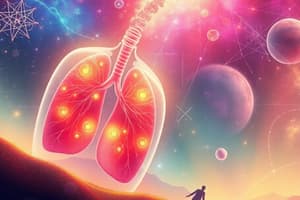Podcast
Questions and Answers
What are the two forces that move water in organisms?
What are the two forces that move water in organisms?
- Pressure potential and solute potential
- Diffusion and osmosis
- Adhesion and cohesion (correct)
- Active and passive transport
What is the overall tendency of a solution to take up water from pure water?
What is the overall tendency of a solution to take up water from pure water?
- Solute potential
- Pressure potential
- Osmotic potential
- Water potential (correct)
What is the measure of the free energy in a volume of water?
What is the measure of the free energy in a volume of water?
- Water potential (correct)
- Osmotic potential
- Pressure potential
- Solute potential
What is the formula for water potential?
What is the formula for water potential?
What does solute potential (ψs) measure?
What does solute potential (ψs) measure?
What is the process of passive transport of a substance from a region of high concentration to one of low concentration?
What is the process of passive transport of a substance from a region of high concentration to one of low concentration?
What are the two tissues involved in the transport system of plants?
What are the two tissues involved in the transport system of plants?
What are the two main reasons why plants need water?
What are the two main reasons why plants need water?
What is the mechanism of water movement across a selectively permeable membrane called?
What is the mechanism of water movement across a selectively permeable membrane called?
What drives secondary active transport or cotransport?
What drives secondary active transport or cotransport?
What is the main energy source for active transport processes?
What is the main energy source for active transport processes?
What is the process of movement of molecules from areas of high to low pressure called?
What is the process of movement of molecules from areas of high to low pressure called?
What do both plants and animals have to increase the area available for gas exchange?
What do both plants and animals have to increase the area available for gas exchange?
What is the main mechanism for short and long-distance transport regulated by membranes?
What is the main mechanism for short and long-distance transport regulated by membranes?
Flashcards are hidden until you start studying
Study Notes
Transport in Multicellular Organisms
- Multicellular organisms must transport fluids and gases within their bodies, including nutrients, water, gases (O2, CO2), waste, and others.
- Plants use pressure gradients and pressure potentials to transport water, minerals, and sugars through specialized tubes, while animals use a pump to move circulatory fluid through tubes called vessels.
- Both plants and animals have evolved highly convoluted surfaces to increase the area available for gas exchange, essential for respiration.
- General means of transport include gravity, pressure gradients, and electrochemical gradients.
- Transport occurs at various levels, including cell-to-cell, tissues, organs, and throughout the body, driven by concentration gradients.
- All transport requires some form of energy, which can be passive (thermodynamically favorable) or active (requiring metabolic energy, often ATP hydrolysis).
- Diffusion, osmosis, and bulk flow are mechanisms of short and long-distance transport, regulated by membranes and affected by factors such as surface area to volume ratio.
- Osmosis is the diffusion of water across a selectively permeable membrane, moving from high to low concentration until equilibrium is reached.
- Active transport, driven by ATP, includes cation pumps such as H+, Na+-K+, and Ca2+ pumps, establishing electrochemical gradients.
- Secondary active transport, or cotransport, moves substances against their concentration gradient, for example, proton pump glucose symporter.
- Long-distance transport is pressure-dependent, occurring via plant and animal vascular systems, driven by mass movement of molecules from areas of high to low pressure.
- Plants need water for physical support, chemical reactions, photosynthesis, temperature control, and transport of solutes, occurring through pathways such as the vascular system.
Studying That Suits You
Use AI to generate personalized quizzes and flashcards to suit your learning preferences.




